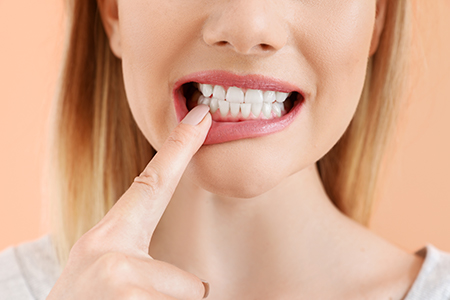Gum disease is the leading cause of adult tooth loss, yet many people don’t realize how common — and how preventable — it can be. Studies show that periodontal conditions affect a large portion of adults over 30, and early detection is the key to preserving teeth and protecting overall health. At the office of Cruzin' Dental, we focus on practical prevention, accurate diagnosis, and treatments that restore function and confidence.
How gum disease starts and why it matters
Gum disease begins when bacteria in dental plaque irritate the tissues that surround and support the teeth. This inflammatory reaction is the body’s response to those bacterial communities and their byproducts. Left unchecked, inflammation that starts at the gumline can progress into deeper tissues that hold teeth in place.
Because early stages of gum disease are often painless, many patients don’t notice a problem until tissue and bone have already been affected. That’s why routine exams and professional cleanings are essential — they let clinicians catch changes before they become irreversible.
Understanding this progression helps patients take sensible preventive steps: consistent home hygiene, regular dental visits, and attention to any early warning signs. These actions dramatically reduce the chance of advanced disease and tooth loss.
Recognizing early warning signs you should not ignore
Detecting periodontal disease early makes treatment more predictable and less invasive. Common early signals include gums that bleed during brushing or flossing, persistent bad breath, or gums that appear swollen and red rather than a healthy pink.
Other signs to watch for are gums that pull away from teeth, increased tooth sensitivity, and a change in how your teeth fit together when you bite. Even subtle shifts in tooth position or new gaps between teeth can indicate underlying tissue loss.
If you notice any of these symptoms, prompt evaluation helps determine whether a reversible problem like gingivitis is present or if a deeper evaluation for periodontitis is needed. Routine periodontal screening is the most reliable way to identify changes early.
Why oral health affects the whole body
Oral tissues are not isolated from the rest of the body. Chronic inflammation in the mouth can influence systemic health through inflammatory mediators and bacterial access to the bloodstream. Research increasingly links periodontal disease with conditions such as cardiovascular disease, diabetes, and respiratory illnesses.
Addressing gum disease is therefore about more than saving teeth; it can reduce inflammation that may affect other organ systems. For people managing chronic medical conditions, coordinated care between dental and medical providers is a smart strategy.
At the office of Cruzin' Dental, our approach emphasizes prevention and careful monitoring to lower the risk of oral inflammation affecting overall health. We work with patients to create realistic plans that fit their health profile and daily routines.
Early-stage gum disease: what gingivitis looks like and how it’s treated
Gingivitis is the earliest, reversible form of gum disease. It usually presents as redness, mild swelling, and bleeding with brushing or flossing. Although it rarely causes pain, gingivitis signals that plaque control needs attention.
Treatment for gingivitis focuses on removing plaque and tartar with professional cleanings, then supporting improved daily oral hygiene. Patient education, tailored home-care techniques, and follow-up cleanings typically restore healthy gum tissue when the condition is addressed promptly.
Successful resolution of gingivitis prevents progression to periodontitis; with commitment from both patient and clinician, the tissues can return to a healthy state and remain stable with regular maintenance.
When disease progresses: understanding periodontitis and its consequences
Periodontitis occurs when inflammation extends beyond the gums to the connective tissues and bone that support teeth. This stage involves destructive changes: pocket formation between teeth and gums, gum recession, and gradual bone loss. Over time, these changes can compromise tooth stability.
Diagnosis relies on a clinical exam, measurements of pocket depth, X-rays to assess bone levels, and a review of contributing factors such as smoking, diabetes, or genetic predisposition. An individualized treatment plan is then developed to halt progression and restore support where possible.
Although periodontitis represents permanent loss of some tissues, modern periodontal therapies aim to control infection, reduce pocket depth, and — when appropriate — regenerate lost bone and connective tissue to improve function and long-term prognosis.
How modern periodontal care is planned and delivered
A practical treatment plan begins with a comprehensive assessment. That includes detailed periodontal charting, radiographic evaluation, and discussion of medical history and lifestyle factors. With that information, clinicians recommend a sequence of care designed to control infection and stabilize the condition.
Treatment often combines meticulous professional cleaning with improved home care, targeted antimicrobial therapies, and ongoing maintenance. For patients who require more advanced intervention, surgical options and regenerative techniques may be appropriate to restore lost structures and make routine cleaning more effective.
Open communication is a priority: we explain each step, expected outcomes, and the maintenance required to preserve improvements. This collaborative approach helps patients make informed choices about their oral health.
Common approaches to treating periodontal disease
-
Conservative (non-surgical) care
When periodontal disease is caught early, non-surgical measures often succeed in restoring a healthy environment. This typically starts with scaling and root planing: careful removal of plaque and hardened deposits below the gumline and smoothing of the root surfaces to discourage re-attachment of bacteria.
Adjunctive therapies such as localized antimicrobial agents or systemic medications can be used in select cases to reduce bacterial load and support healing. The goal of conservative care is to reduce pocket depths, control inflammation, and enable easier home maintenance.
Regular periodontal maintenance visits after initial therapy are critical to hold gains and prevent recurrence. These visits are tailored to each patient’s risk level and response to treatment.
-
Surgical and regenerative options
When pockets are deep or when structural damage limits the effectiveness of non-surgical therapy, surgical treatment can access hard-to-reach areas to remove bacteria and reshape tissue and bone. Flap procedures allow direct visualization and cleaning of root surfaces and underlying structures.
Regenerative techniques, including bone grafts and guided tissue regeneration, are available to rebuild lost bone and connective tissue in appropriate cases. These procedures can improve tooth support and enhance long-term outcomes when indicated.
Advanced tools such as dental lasers are also used selectively to assist in pocket reduction and tissue recontouring. The choice of surgical approach is based on individualized assessment and realistic expectations for healing.
Good periodontal care is a partnership: combining professional expertise, effective therapies, and consistent home care gives the best chance of preserving natural teeth and protecting overall health. If you’d like to learn more about how periodontal treatment might apply to your situation, contact us for more information.







